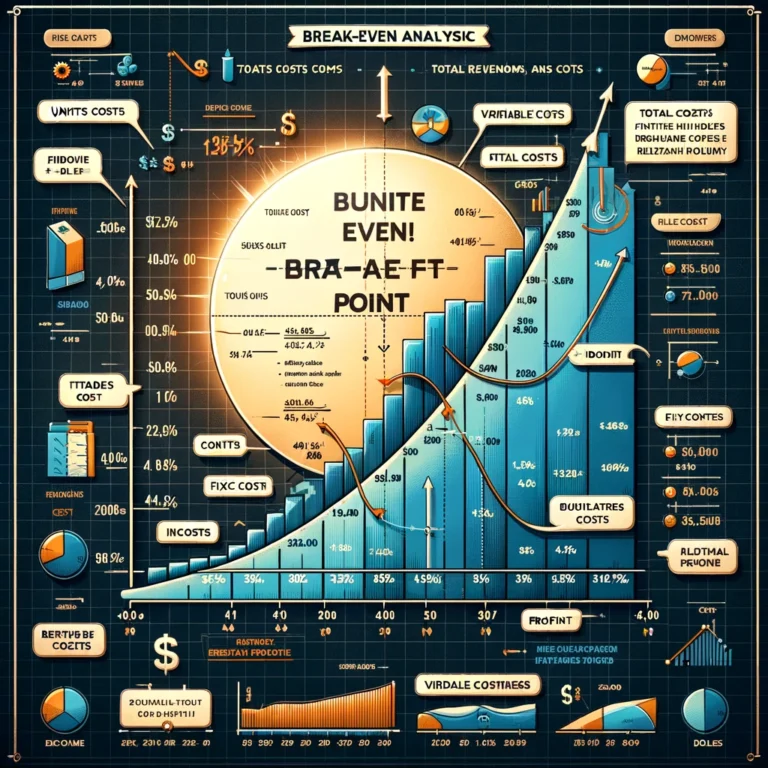Break-even Analysis in Business and Management
Break-even analysis is a crucial financial tool used to calculate the point at which a business's revenues exactly match its expenses—hence, the term "break-even." It is a critical concept within the field of business and management, particularly for decision-making regarding product pricing, cost management, and investment analysis. This detailed exploration will cover the fundamentals of break-even analysis, its strategic implications, benefits, limitations, and practical application within an industry context, tailored for students engaging with IB Business & Management studies.
Understanding Break-even Analysis
Fundamentals: Break-even analysis involves determining the point at which total costs and total revenues are equal, indicating that a business is neither making a profit nor incurring a loss. This point is referred to as the "break-even point" (BEP) and is measured in units of production or sales.
Components:
- Fixed Costs: Costs that do not change with the level of output. Examples include rent, salaries, and insurance premiums.
- Variable Costs: Costs that vary directly with the level of production or service provision. This includes costs like raw materials and direct labor.
- Sales Price per Unit: The amount of money charged for each unit of product or service sold.
Formula and Calculation
The basic formula for calculating the break-even point in units is:
BEP (in units) = Fixed Costs / (Sales Price per Unit - Variable Cost per Unit)
To calculate the break-even point in sales value, the formula is:
BEP (in sales value) = BEP (in units) × Sales Price per Unit
Strategic Implications
- Pricing Decisions: Break-even analysis plays a vital role in setting prices by providing a clear understanding of how pricing affects the volume of sales required to cover costs.
- Cost Control: Identifying the break-even point helps businesses understand the impact of fixed and variable costs on their operations, guiding efforts to optimize expenses.
- Investment Appraisal: It aids in evaluating the viability of new projects or investments by showing how changes in costs or prices impact profitability.
- Risk Management: Break-even analysis is crucial for assessing financial risk, showing how different scenarios (e.g., increased costs, decreased prices) affect the company's financial health.
Benefits and Limitations
Benefits:
- Simplicity: Offers an easy-to-understand metric for financial planning.
- Decision-making: Helps in making informed decisions about product development, pricing, and marketing strategies.
- Risk Assessment: Assists in evaluating the risk associated with launching new products or entering new markets.
Limitations:
- Oversimplification: May not capture the complexity of real-world operations, such as changes in consumer behavior or market conditions.
- Fixed Cost Assumption: Assumes fixed costs remain constant, which may not hold for all business scales.
- Single Product Focus: Less effective for companies with multiple products due to the difficulty in allocating costs accurately.
Industry Example: The Coffee Shop Industry
Consider the example of a hypothetical company, "CafeBrew," operating in the competitive coffee shop industry planning to introduce a new specialty coffee blend. To determine the viability of this new product, CafeBrew conducts a break-even analysis with the following details:
- Fixed Costs: $20,000 (equipment, rent, salaries)
- Variable Cost per Unit: $2 (coffee beans, milk, sugar)
- Sales Price per Unit: $5
Using the break-even formula, CafeBrew needs to sell approximately 6,667 cups of the specialty blend to break even.
Strategic Implications
- Knowing the BEP helps CafeBrew in setting realistic sales targets and evaluating the feasibility of the new coffee blend launch.
- CafeBrew can use this analysis to explore ways to reduce variable costs or to reassess its pricing strategy to improve profitability.
- The company can also assess the impact of increasing fixed costs on the break-even volume, aiding in budget allocation decisions.
Conclusion
Determining the break-even point is a fundamental financial exercise that provides critical insights into a business's operational and financial strategy. It aids in assessing the viability of products or services, informing pricing strategies, guiding cost management efforts, and supporting strategic decision-making. The example of CafeBrew illustrates how break-even analysis can be applied in the highly competitive coffee shop industry to inform production, pricing, and sales strategies. For IB Business & Management students, mastering break-even analysis equips them with a valuable tool for analyzing business scenarios, facilitating strategic planning, and enhancing operational decision-making in their future careers.







